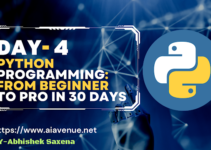Introduction
Python is a high-level, interpreted programming language that has gained significant popularity in recent years due to its simplicity and versatility. Originally developed in the late 1980s, Python has since evolved to become one of the most widely used programming languages in the world, with applications in data science, machine learning, web development, automation, and artificial intelligence. In this article, we will explore the advancements and applications of Python programming and its potential impact on future technology.
- Data Science and Machine Learning
Python’s ease of use and extensive libraries have made it a popular choice for data scientists and machine learning engineers. Python’s libraries, such as NumPy, Pandas, and Matplotlib, provide powerful tools for data manipulation, analysis, and visualization. The popularity of Python in data science has also led to the development of specialized libraries such as Scikit-learn, TensorFlow, and PyTorch, which provide machine learning algorithms and frameworks for building and training models.
In 2023, we can expect to see continued advancements in Python libraries for data science and machine learning, with a focus on improving performance and scalability. The development of new libraries and tools will also enable easier integration of machine learning models into business operations, leading to increased automation and efficiency.
- Web Development
Python’s versatility extends beyond data science and machine learning, with many web developers using it for server-side programming. The Python web framework, Django, provides a robust platform for building scalable and secure web applications. Flask, another popular web framework, is lightweight and flexible, making it an excellent choice for smaller projects.
In 2023, we can expect to see advancements in Python web development, with a focus on improving performance and security. The development of new web frameworks will also enable developers to build more complex and feature-rich applications, leading to enhanced user experiences.
- Automation and Robotics
Python’s ease of use and versatility have made it a popular choice for automation and robotics. Python’s libraries and tools, such as PyAutoGUI, provide a powerful platform for automating repetitive tasks, while the Python Robotics library provides a framework for building and controlling robots.
In 2023, we can expect to see continued advancements in Python’s automation and robotics capabilities, with a focus on improving performance and functionality. The development of new libraries and tools will also enable the integration of Python into more complex robotics systems, leading to increased automation and efficiency.
“Discover Python Programming from Scratch – Day 1” – Read more here: https://www.aiavenue.net/2023/03/day-1-python-programming-from-beginner.html
- Artificial Intelligence
Python’s popularity in data science and machine learning has also made it a preferred language for artificial intelligence (AI). Python’s libraries and frameworks, such as TensorFlow and PyTorch, provide powerful tools for building and training AI models. Python’s simplicity and ease of use also make it an excellent choice for developing AI applications.
In 2023, we can expect to see continued advancements in Python’s AI capabilities, with a focus on improving performance and scalability. The development of new libraries and tools will also enable the integration of AI models into more complex systems, leading to enhanced automation and efficiency.
Conclusion
Python has come a long way since its development in the late 1980s, and in 2023, we can expect to see continued advancements in its capabilities and applications. The popularity of Python in data science, machine learning, web development, automation, and artificial intelligence has made it a versatile and widely used programming language. As we continue to push the boundaries of what Python can do, it is essential to ensure that its use is ethical, responsible, and beneficial to society.
“Discover Python Programming from Scratch – Day 1” – Read more here: https://www.aiavenue.net/2023/03/day-1-python-programming-from-beginner.html

